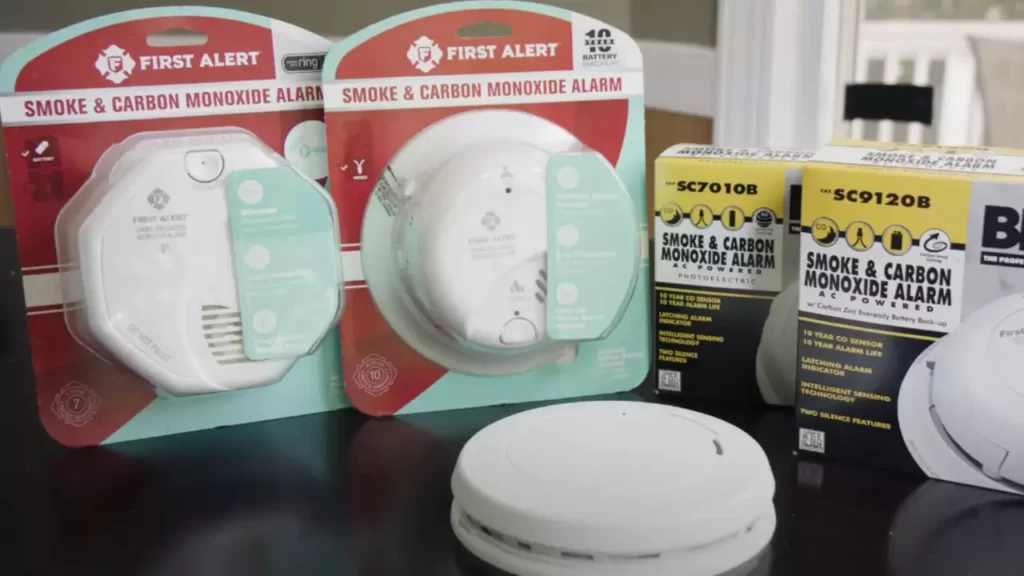To install a fire detector, follow these steps: First, choose a suitable location and mount the detector on the ceiling. Then, make sure to connect the detector to a power source and test it to ensure proper functioning.
Fire detectors are essential safety devices that can save lives and protect property from the devastating effects of fires. Installing a fire detector in your home or workplace is a simple yet crucial step in fire prevention. By detecting smoke or heat, these devices provide early warnings, allowing occupants to evacuate and alerting emergency responders.
However, correct installation is essential to ensure the effectiveness of the fire detector. We will guide you through the process of installing a fire detector, helping you take proactive measures to enhance safety and protection. Following these steps will enable you to confidently install a fire detector and provide peace of mind for yourself and those around you. So, let’s get started!
Understanding The Importance Of Fire Detectors
When it comes to home safety, fire protection should be a top priority. One of the most crucial tools in fire safety is a fire detector. Installing fire detectors in your home can mean the difference between life and death in the event of a fire. In this blog post, we will explore the importance of fire detectors, the effectiveness of these devices, and their role in early fire detection and prevention.
Importance of Fire Detectors in Home Safety
Fire detectors play a crucial role in ensuring the safety of your home and loved ones. These devices are designed to detect the presence of smoke or fire and alert you immediately, giving you precious time to evacuate and call for help. By installing fire detectors in your home, you are taking a proactive step towards safeguarding your property and the lives of your family members.
Statistics on the Effectiveness of Fire Detectors
The effectiveness of fire detectors cannot be underestimated. According to recent statistics, homes with working fire detectors have a significantly higher chance of escaping a fire unharmed. In fact, studies have shown that households with functioning fire detectors experience a 50% reduction in fire-related fatalities.
Furthermore, data reveals that approximately 60% of fire-related deaths occur in properties without fire detectors or with non-functioning ones. This highlights the importance of regularly testing and maintaining these devices to ensure optimal performance.
Role of Fire Detectors in Early Fire Detection and Prevention
Fire detectors play a vital role in early fire detection and prevention. They are designed to detect the presence of smoke or fire at the earliest stage possible, giving you the opportunity to take immediate action. Early detection allows you to notify the fire department promptly, preventing the fire from spreading and minimizing damage. It can also buy you the time needed to evacuate safely and reduce the risk of injuries or fatalities.
Moreover, fire detectors can serve as a preventive measure by alerting you to potential fire hazards in your home. For instance, they can detect an overheating electrical appliance or a smoldering fire caused by a cigarette. By identifying these risks early on, you can take the necessary precautions to prevent a full-blown fire from occurring.
Installing fire detectors throughout your home, including in each bedroom and on every level, is critical to ensuring comprehensive fire protection. Remember to test your fire detectors regularly and replace the batteries as needed. By understanding the importance of fire detectors and taking the necessary steps to ensure their effectiveness, you are taking significant strides towards keeping your home and loved ones safe from the devastating effects of fire.

Preparing For Fire Detector Installation
Before you start installing a fire detector in your home, there are a few steps you need to take to ensure a smooth and successful installation process. By preparing ahead of time, you can guarantee the safety of your household and minimize the risk of fire-related accidents.
Types of Fire Detectors: Ionization vs. Photoelectric
When it comes to fire detectors, there are two main types: ionization and photoelectric detectors. Each type has its own strengths and weaknesses, making it important to choose the one that best suits your needs.
Ionization detectors are excellent at detecting fast, flaming fires, making them ideal for areas where fires are likely to spread quickly, such as kitchens. These detectors contain a small amount of radioactive material, which ionizes the air and causes the alarm to sound when smoke is detected.
On the other hand, photoelectric detectors are more effective at detecting slow, smoldering fires. They use a beam of light and a light receptor to detect smoke particles. These detectors are often recommended for bedrooms, living rooms, and hallways, as they provide early warning for more common types of fires.
Choosing the Right Fire Detector for Your Home
When choosing a fire detector for your home, it is crucial to consider factors such as the size of your home, the number of rooms, and the potential fire hazards present. Here are a few key points to keep in mind:
- Ensure that the fire detector you choose is certified by a reputable testing laboratory, such as Underwriters Laboratories (UL).
- Consider whether you want a battery-operated detector or one that is hardwired into your home’s electrical system.
- If you opt for a battery-operated detector, check the battery life and make it a habit to test and replace the batteries regularly.
- Take note of any specific requirements or regulations set by your local authorities or homeowner’s association.
Considerations for Placement of Fire Detectors
To maximize the effectiveness of your fire detectors, proper placement is crucial. Follow these guidelines:
- Install a fire detector on every level of your home, including the basement and attic.
- Place detectors near sleeping areas, as well as inside each bedroom.
- Avoid installing detectors near windows, doors, or vents, as this may affect their sensitivity.
- For kitchens, install detectors at least 10 feet away from cooking appliances to prevent false alarms.
- In garages, workshops, or other areas with high levels of dust or fumes, consider installing detectors specifically designed for these environments.
By understanding the different types of fire detectors, choosing the right one for your home, and properly placing them throughout your living spaces, you can significantly enhance the safety of your household. Implementing these measures will provide you with peace of mind, knowing that you have taken the necessary steps to protect your loved ones and belongings.

Step-By-Step Guide To Installing Fire Detectors
Installing fire detectors is a crucial step in ensuring the safety of your home or workplace. With the right tools and equipment, proper planning, and careful execution, you can have your fire detectors up and running in no time. In this step-by-step guide, we will walk you through the process of installing fire detectors, from gathering the necessary tools and equipment to testing and activating the detectors. So, let’s get started!
Gathering the Necessary Tools and Equipment
Before you begin installing fire detectors, it’s important to gather all the necessary tools and equipment. This will ensure that you have everything you need within arm’s reach, saving you time and frustration. Here’s a list of the items you’ll need:
- Fire detectors
- Drill
- Screwdriver
- Wire stripper
- Wire nuts
- Electrical tape
- Batteries (if applicable)
Locating the Ideal Positions for Fire Detectors
Now that you have all the necessary tools and equipment, it’s time to determine the ideal positions for your fire detectors. The placement of fire detectors is crucial as it can significantly impact their effectiveness. Here are a few tips to keep in mind:
- Install fire detectors on each level of your home or workplace.
- Place detectors near bedrooms and sleeping areas.
- Install detectors in common areas such as living rooms and hallways.
- Avoid installing detectors near ventilation or air conditioning units.
Installing the Fire Detectors: Wired vs. Wireless
When it comes to installing fire detectors, you have the option to choose between wired and wireless systems. Each has its advantages and disadvantages, and the choice ultimately depends on your specific needs and preferences.
If you opt for wired fire detectors, you’ll need to run electrical wires through the walls to connect them to a power source. This method ensures a stable connection but may require professional assistance.
On the other hand, wireless fire detectors offer greater flexibility and ease of installation. These detectors communicate with each other wirelessly, eliminating the need for complicated wiring. They are battery-powered, making them ideal for areas where electrical wiring is difficult or impossible.
Testing and Activating the Fire Detectors
Once you have installed the fire detectors, it’s crucial to test them to ensure they are functioning properly. Here’s a step-by-step process to activate and test your fire detectors:
- Make sure the batteries are properly inserted (if applicable) and the detectors are securely mounted.
- Press the test button on each detector to activate the alarm.
- Check if the alarm sound is loud and clear.
- Ensure that all detectors are interconnected, so if one alarm goes off, all the detectors in your home or workplace will sound.
Regularly test your fire detectors to ensure they continue to function effectively. Replace batteries as needed and keep an eye out for any signs of malfunction.
By following this step-by-step guide, you can successfully install fire detectors and enhance the safety of your home or workplace. Remember, proper installation and regular maintenance are key to ensuring your fire detectors are ready to protect you in case of an emergency.
Frequently Asked Questions
Can I Install My Own Fire Detector?
Yes, you can install your own fire detector, but make sure to follow these guidelines: 1) Read the instruction manual thoroughly. 2) Place the detector on the ceiling or high on a wall, away from any obstructions. 3) Test the detector regularly to ensure it’s working properly.
4) Replace the batteries regularly. 5) Consider consulting a professional for advanced installations.
Do You Need An Electrician To Install A Fire Alarm?
No, an electrician is not necessary to install a fire alarm. However, it is recommended to hire a professional to ensure proper installation and compliance with safety standards.
How Do You Install A Fire Alarm Step By Step?
To install a fire alarm, follow these steps: 1. Choose a suitable location for the alarm. 2. Turn off the power before installation. 3. Mount the alarm on the wall or ceiling. 4. Connect the alarm to the electrical wiring. 5.
Test the alarm to ensure it’s functioning properly. Remember to follow the manufacturer’s instructions for your specific fire alarm model.
Should Smoke Detectors Be Mounted On The Wall Or Ceiling?
Smoke detectors should be mounted on the ceiling for optimal operation.
Conclusion
Installing a fire detector is a crucial step in ensuring the safety of your home or office. By following the steps outlined in this guide, you can easily set up and maintain your fire detector. Remember to regularly test and replace batteries to keep it functioning properly.
Don’t compromise on the safety of your loved ones or your valuable possessions. Take action today and install a fire detector for peace of mind.
